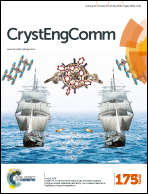Epitaxial growth of atomically flat KBr(111) films via a thin film ionic liquid in a vacuum†
Abstract
The NaCl-type crystal (111) polar face is electrostatically so unstable that its atomically flat (111) surface has been difficult to obtain so far. In this work, based on our preliminary results on flat KBr(111) microcrystals on an α-Al2O3(0001) substrate grown via ionic liquid droplets by vacuum deposition, we have achieved atomically flat, epitaxial KBr(111) films grown all over an α-Al2O3(0001) substrate. The key point to this success is the great improvement in the wettability of the ionic liquid on the substrate by introducing an amorphous-like “wetting layer”. Furthermore, in situ growth monitoring by means of an optical microscope with a long-distance focus lens reveals the growth process in the ionic liquid: random nucleation occurs directly on the substrate, but not in the ionic liquid, and subsequently, the nucleated KBr islands grow more rapidly in the in-plane direction rather than in the out-of-plane direction to coalesce with each other, forming a continuous KBr film over the substrate. The lateral overgrowth mechanism is proposed to explain the epitaxial growth of KBr(111) films even on the amorphous-like wetting layer/α-Al2O3(0001) substrate on the basis of a cross-sectional TEM observation.



 Please wait while we load your content...
Please wait while we load your content...